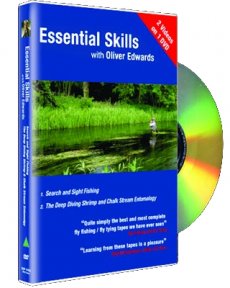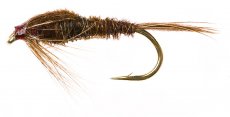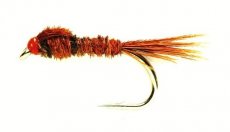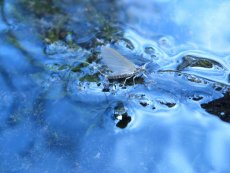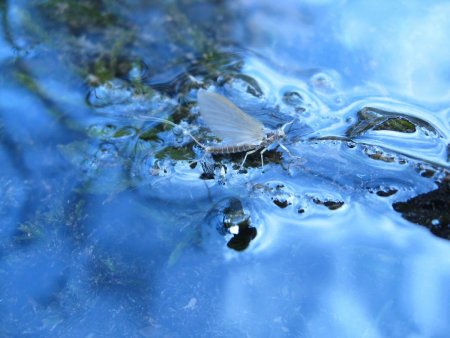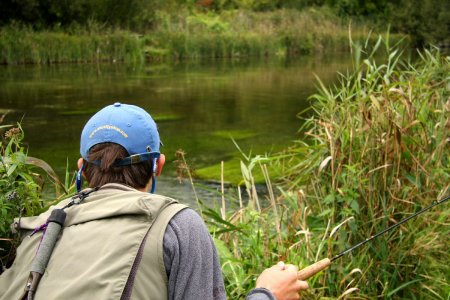You can count on your hands the flies that have truly survived the test of time and become established world classics and Frank Sawyer’s Pheasant Tail Nymph (PTN) is, without question, up there in the all time hall of fame.
Re-produced from an article originally published in Fly Fishing and Fly Tying Magazine
You can count on your hands the flies that have truly survived the test of time and become established world classics and Frank Sawyer's Pheasant Tail Nymph (PTN) is, without question, up there in the all time hall of fame. Casting this little gem of a fly to sighted fish is one of the most exhilarating ways to tap into its mercurial qualities, for it is while fishing in this style that you follow every inch of your nymph's drift, every twitch from your target fish and, if the piscatorial planets align, the moment when the fish tears off with your fly. Sawyer, who worked as a river keeper on the Wiltshire Avon in the early 1900s, regularly fished in this way and arguably conjured up the PTN especially for sight fishing to trout and grayling, which he said required a level skill that: "surpasses the high art of dry fly."
The Success of the Pheasant Tail Nymph
This workhorse of a fly must have accounted for more fish than there are cat's eyes on the M25, and it is little wonder that most fly boxes are home to a small army of this barbed assassin. Who would have thought that a few quills from a pheasant's tail, a little copper transformer wire and a shard of metal could prove to be such a deadly combination?
So what exactly does the PTN imitate and why is it so successful? Sawyer, a dedicated stream ecologist and pioneering conservationist, originally designed the PTN to mimic the aquatic stage of the 'agile darter' nymphs, or more specifically several species from the Baetis family (Mayflies - Olives). During his early fly tying years Sawyer strived to make exact copies of natural invertebrates, and even different stages of one species, but as the years passed by and after countless days spent on the water, he discovered that detailed imitations where not necessary: "I found that there was no need for any exact likeness of one or another [insect] and that if most of the details and characteristics of several species could be incorporated.... fish could be taken consistently on them." There is no doubt that the PTN is a good general impression of size and shape of a variety of Baetis nymphs, but it also passes off as other forms of aquatic life (e.g. Chironomids). More than anything else, the PTN owes its success to this universal buggy appearance. Fished correctly it is lethal.
Another key to the PTN's world domination, from the fly fisher's perspective, is the simplicity of its design. Created by Sawyer's practical and intelligent mind, the PTN is consistent with other classic patterns (e.g. hares ear, elk hair caddis). It is quick and straightforward to tie and the materials are cheap and relatively easy to acquire - all important qualities for a fly equipped to conquer the world. After all, a fly that requires several quills from the crest of a golden eagle is hardly going to become a classic! On fly tying, Sawyer himself said: "simplicity is an aim to be desired."
They say that imitation is the greatest form of flattery and like all great things in life the PTN has inspired an array of variations. Go to any fly shop and you are likely to find more versions of the PTN than there are covers of, Paul McCartney's "Yesterday", ranging from those with orange spots and pearl wing cases to beaded bombs sporting sparkling tail fibres. While the raft of variations may have their unique catching abilities, if not of fish then certainly of fly fishers, what is far more important than the particular version in your fly box is the confidence and manner in which the fly is fished; it is presentation not imitation that catches trout.
Tackle tactics and techniques
Fly size and weight
Choice of fly size and weight obviously depends on the depth of your target fish, the power of the current, the size of natural you wish to imitate (e.g. size 16 for a Baetis rhodani nymph - LDO), if any, and the strength of your tippet. Although I carry a handful of PTNs in different size and weights, my 'old faithful', whether I am sight or blind fishing, is a size 16 weighted PTN which I cast with confidence (see box below). I like to fish this marvellous little fly NZ style 3½ feet behind a visible dry fly (e.g. Adams Parachute) which picks up plenty of bonus fish and doubles up as a subtle strike indicator. Dry indicators are not only useful for detecting takes and suspending your nymph at the desired depth, but also for revealing the movement of surface currents which can help to reduce one of the fly fisher's biggest challenges when sight fishing the PTN - 'drag' and 'micro-drag'.
Drag and micro-drag
I first encountered 'micro-drag' when fishing on the magnificently clear and turbulent streams that abound in New Zealand's South Island. My friend and master nymph fisherman, Simon Chu, explained to me that undetectable sub-surface drag, only perceptible to the fish, is often responsible for rejections. This train of thought is echoed by Czech nymph connoisseur Karel Krivanec in his excellent book, 'Czech Nymph'. We tend to think of drag as our leader, or worse still our fly, scraping the surface or visibly dragging through the water. That though, is only half the story. Once underwater, the leader is at the mercy of sub-surface currents and while it may appear from the surface as if everything is fine, dandy and drag free, there is every chance the leader may be experiencing 'micro-drag'. This has the potential to give an unnatural waver to the fly's drift rendering it, from the fish's perspective, as nothing more than stream debris or worse still as an alarm bell.
With drag reduction in mind I use a long (13-14ft), relative to my 8'6 #4 rod, fine diameter leader (rio-copolymer) which helps in the eternal quest to avoid drag and ultimately results in more hook-ups. I also regularly degrease the last 8ft of the leader using 'Orvis Mud' (Fuller's Earth) which reduces leader flash and assists in surface film penetration. Although sometimes tedious, regular degreasing can make all the difference. The extra weight of the mud also helps the leader to sink down through the water column which is handy when trying to deliver your nymph to the fish's doorstep.
Spotting fish and making the cast
One of the most exciting elements of sight fishing the PTN is the thrill of searching for and finding fish. The secret to spotting fish is to move slowly, systematically scouring the bottom for any shapes that differ from the general pattern of the river bed (see my article Trouting in the Land of the Long White Cloudat www.wildaboutfishing.co.uk). Searching for fish without polarised glasses is like driving at night without your headlights on so be sure to have some to hand.
Having laid eyes on a feeding fish, it is all about an ultra-stealthy approach, creeping into a casting position and getting your fly into the heart of fish's feeding zone as subtly and as quickly as possible. When stalking it is worth bearing in mind that due to the light refracting qualities of water and the 97 degree window of trout vision, fish nearer the surface are less likely to see you than those that are lying deeper. Remember too that if you see a fish on the fin or nymphing from side to side, don't waste any time as they tend to switch off as quickly as they switch on; strike while the iron is hot and get that cast off.
While downstream casts to sighted fish can sometimes be useful, casting upstream and at a slight angle is generally best. Casting at an angle, rather than directly over the fish, ensures the drifting nymph arrives at the fish just before the leader, reducing the danger of 'lining' the fish. It is also imperative that your fly is fishing at the right depth. It is so easy to spray some casts over a fish and declare it inactive or not interested in the fly when, in fact, the offering was never drifting in the fish's feeding zone in the first place - this is why the introduction of tungsten beads have improved so many peoples catch rates. Weighted flies, long degreased leaders, fine diameter tippets and an emphasis on casting way upstream of the target fish will all help to get that fly in the zone.
Detecting the take
Detecting a take when sight fishing the PTN can be a tricky business, but using a combination of monitoring the sinking speed of the leader, the drifting nymph, every move of the target fish and the dry indicator can give you the edge. Having made the cast, I immediately try to lock on to the PTN as it sinks through the water column and drifts tantalisingly towards the gaping jaws of the fish. However, as Oliver Edwards observes in his excellent essential skills series, you often loose sight of the PTN due to the ripples it puts out upon entry to the water. Assuming this happens, I predict the drifting speed of the nymph and switch my attention to the fish in anticipation of any vertical or horizontal shift in its position, for even the slightest twitch of a fin or flinch of flank can belie a take.
In some cases it is possible to see the whites of the fish's mouth as it chomps down on the fly or a puff of the gills as the fish turns on the suction. If, however, your nymph is drifting on a direct collision course with the fish's mouth or if visibility is impeded, there may be no way of telling whether or not it has inhaled the fly. To combat this problem I try to cast a few inches to the near side of my target which forces the fish to move a short distance to intercept the drifting nymph. If the fish travels towards the fly it will inevitably have taken or rejected it the instant it starts to turn back to its lie. Lifting the rod at this point is a safe bet and often results in that fantastic feeling of solid contact.
The induced take
Dead drifting a nymph is my standard tactic when sight fishing the PTN, but there are always some fish that show about as much interest in the fly as a dog shows in a bowl of lettuce. This often happens when fish are keyed in on ascending nymphs or when rod pressure is high. Enter the 'induced take'. Despite being aware of this technique for years, I had no idea just how effective it could be until an unforgettable experience on a far away stream down-under. My pheasant tail had passed by a seemingly disinterested 7lb wild brown perhaps a dozen times without so much as a sniff. Wondering whether the fish was in fact a trout statue carefully placed on the riverbed, I started to reel in, despairingly hoisting my fly up and over the fish's head as I did so. In a blink of an eye, the spotted leviathan sprang into life and rocketed towards the surface before seizing the rising fly just below the surface and plunging back into the clear pool with extraordinary and unstoppable power. My tippet was smashed to smithereens!
The induced take is now a major part of my armoury, when sight or even blind fishing the PTN. Hoisting or twitching the nymph towards the surface simulates an ascending or darting nymph which is a clear prey cue for trout and especially grayling. How exactly you induce the take (i.e. a slow lift, one twitch etc.) is a matter of personal choice, but I like to twitch the fly just once as the nymph enters fish's visual window. Fished correctly this well known method can be the magic potion which transforms a difficult fish into a ravenous hungry predator eager to engulf your fly.
There are few things in life that equal the thrill of spotting, stalking and casting to a sighted fish and the PTN lends itself to this style of fishing. I for one owe Frank Sawyer more than just a few pints of the good stuff! Just imagine his delight if he new how much pleasure his PTN would bring to fly fishers across the world from those who cast on the spring creeks in Montana or on the vast clear streams of Patagonia to the throngs of anglers who follow in his footsteps on the Wiltshire Avon. This marvellous little fly is a true world beater, so if you know of a clear stream where you can spot fish in your neck of the woods, why not whip out Frank Sawyer's Pheasant Tail Nymph and go sight fishing?
Information
Website: Robert has a website to support his writing and photography: www.wildaboutfishing.co.uk
PTN You Tube Video: You can watch Frank Sawyer tying his PTN on YouTube:http://www.youtube.com/watch?v=416Os9V84n8
Book: Sawyers excellent book, Nymphs and the Trout (originally published 1958) describes in detail how to tie and fish the PTN.
Essential Skills: Search and Sight Fishing from Oliver Edward's Essential Skills series has some excellent tips for fishing the PTN:
The PTN
Sawyer's Pheasant Tail Nymph
Hook: 2XL round or perfect bend 14-1TMC 100
Thread/under-body/weight: Fine dark copper transformer wire
Body, tail and thorax cover: 4 Cock pheasant tail fibres
My Favoured Pheasant Tail Nymph Variation (beaded tungsten 2-4mm/ lightly weighted/un-weighted)
Hook: Size 14-18 TMC 100
Thread: Black 8/0
Under body: Lead wire (tapered)
Body and tail: 4 Cock pheasant tail fibres
Thorax cover: 4 Cock pheasant tail fibres
Ribbing: Fine copper wire
Adams Parachute
Hook: Size 10-18 TMC 100
Thread: Black UNI thread 8/0
Parachute: Grizzle hackle
Sight post: White polypropylene yarn
Body: Grey muskrat or rabbit
Tail: Brown and grizzle hackle fibres








